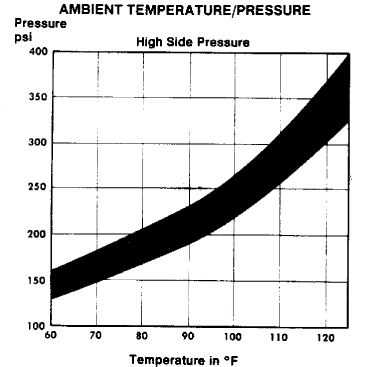A/C SYSTEM DIAGNOSIS
1988 Jeep Cherokee
1988 AIR CONDITIONING & HEAT
A/C General Servicing
Diagnostic Procedures
Jeep; All Models
DIAGNOSTIC PROCEDURES
Diagnosis is an important first step in A/C system servicing.
To save time and effort, systems should be carefully checked to
identify the causes of poor performance. By using the following
diagnostic charts, defective components or system damage can be
quickly located. To identify problems that are specific to one system,
refer to the repair section of this manual. The charts in this section
apply to all systems.
PREPARATION FOR TESTING
1) Attach Low and High side gauges.
2) Start engine and allow it to warm up.
3) Set system to COOL and blower to HIGH.
4) Open car doors and hood.
5) Run at fast idle for 2-3 minutes.
ALTITUDE PRESSURE VARIATIONS TABLE
ALTITUDE PRESSURE VARIATIONS TABLE
Altitude Absolute Gauge Altitude
(Ft.Above Pressure Of Correction
Sea Level) Atmosphere (psi) (1) (psi)
0 .......................... 14.7 .............................. 0
1000 ....................... 14.2 ............................ 0.5
2000 ....................... 13.7 ............................ 1.0
3000 ....................... 13.2 ............................ 1.5
4000 ....................... 12.7 ............................ 2.0
5000 ....................... 12.2 ............................ 2.5
6000 ....................... 11.7 ............................ 3.0
7000 ....................... 11.3 ............................ 3.4
8000 ....................... 10.9 ............................ 3.8
9000 ....................... 10.5 ............................ 4.2
10,000 ..................... 10.1 ............................ 4.6
(1) - Add correction shown from gauge readings
ALTITUDE VACUUM VARIATIONS TABLE
ALTITUDE VACUUM VARIATIONS TABLE
Altitude Complete Gauge Altitude
(Ft.Above Vacuum Correction
Sea Level) (In. Hg) (1) (In. Hg)
0 .......................... 29.92 ............................. 0
1000 ....................... 28.92 ........................... 1.0
2000 ....................... 27.82 ........................... 2.1
3000 ....................... 26.82 ........................... 3.1
4000 ....................... 25.82 ........................... 4.1
5000 ....................... 24.92 ........................... 5.0
6000 ....................... 23.92 ........................... 6.0
7000 ....................... 23.02 ........................... 6.9
8000 ....................... 22.22 ........................... 7.7
9000 ....................... 21.32 ........................... 8.6
10,000 ..................... 20.52 ........................... 9.4
(1) - Add correction shown to gauge readings
OPERATIONAL TEST GAUGE READINGS
Normal System Operating Pressures (PSI) (1)
Low Side High Side
Gauge Gauge
Application (Suct.) (Disc.)
Jeep 1980-87
(Thermostatic Switch) ........ 5-24 ................... 208-250
1988
(Accumulator Type) ........... 24-50 .................. 160-250
(1) - Pressure readings given are for a system in good operating
condition, at sea level and an ambient temperature of 80
(27
FC).AIR CONDITIONING SYSTEM PERFORMANCE CHECK TABLE
PERFORM TESTS: SHOULD BE: IF:
Temperature Check Temperature Check is
* Switch to LOW
blower
* Close doors Too warm-Check control lever
* Check outlet 35-45
temperature. cooling system and gauge
readings.
F (1.7-7.2 C) operation, heater water valve,Visual Check Visual Check Shows:
* Compressor Quiet, no leaks Noisy-Check belts, oil level,
seals, gaskets, reed valves.
* Condenser Free of Blocked-Clean off. Pluggedobstructions
Flush or replace.
* Receiver- Dry and warm to Frosty-Check for restriction,
Drier touch. replace desiccant.
* Sight Glass Clear or few Bubbly, foamy or streaksbubbles
Check gauge readings.
* High Side Dry and warm to Frosty or very hot-Check for
touch. restriction or overcharge.
* Low Side Dry and cool to Frosty or warm-Check for
Lines touch. restriction, low charge or
bad valve.
* Expansion Dry Frosty-Check for moisture or
Valve restriction. Check sensing
bulb.
* STV Dry and cool to Frosty or warm-Check gauge
touch. readings for valve malfunction
* Evaporator Dry and cold to Freezing or warm-Check
touch. expansion valve, STV or thermo
switch.
Gauge Readings Gauge Readings are
* High Side See Pressure Above or below normal-See A/C
Gauge Chart Diagnosis on next page.
* Low Side See Pressure Above or below normal-See A/C
Gauge Chart Diagnosis on next page.

Fig. 1: AMBIENT TEMPERATURE/PRESSURE
Fig. 2: EVAPORATOR TEMPERATURE/PRESSURE
AIR CONDITIONING DIAGNOSIS WITH GAUGES FOR SYSTEMS WITH
INSUFFICIENT OR NO COOLING
LOW SIDE HIGH SIDE OTHER SYMPTOMS (1) DIAGNOSIS
GAUGE GAUGE
Normal Normal No or few bubbles in sight Some Air and
glass. High side gauge may Moisture in System.
go high. Low side gauge
does not fluctuate with
compressor on/off cycle.
Normal Normal Cools okay in morning but Excessive Moisture
not during hot part of day.
Tiny bubbles in sight glass.
Discharge air warm when low
side gauge drops into vacuum.
Normal Normal Thermostatic switch system Defective Thermoonly-
compressor cycles off static Switch
and on too rapidly.
Normal Normal Cycling clutch systems Misadjusted Thermoonly-
Compressor doesn’t static Switch or
turn on soon enough. or Defective
Discharge air becomes Pressure Sensing
warm as low side pressure Switch
rises.
Low Low Bubbles in sight glass. Low R-12 Charge
Outlet air slightly cool.
Low Low Sight glass clear or oil- Excessively Low
streaked. Outlet air very R-12 Charge
warm.
Low Low Outlet air slightly cool. Expansion Valve
Sweating or frost at Stuck Closed.
at expansion valve. Screen Plugged or
Sensing Bulb
Malfunction.
Low Low Outlet air slightly Restriction on High
cool. High side line Side
cool to touch. Sweating
or frost on high side.
Low High Evaporator outlet pipe STV Stuck Open
cold. Low side goes
into vacuum when blower
is disconnected.
High Low Evaporator outlet pipe STV Stuck Open
warm. Outlet air warm.
High Low Noise from compressor. Compressor
Malfunction
High High Outlet air warm. Liquid Condenser
line very hot. Bubbles Malfunction or R-12
in sight glass. Overcharge.
High High Outlet air slightly cool. Large Amount of Air
Bubbles in sight glass. and Moisture in
System.
High High Outlet air warm. Expansion Valve
Evaporator outlet Stuck Open
sweating and frost.
(1) - If equipped with a low refrigerant charge protection system,
compressor operation may have stopped.